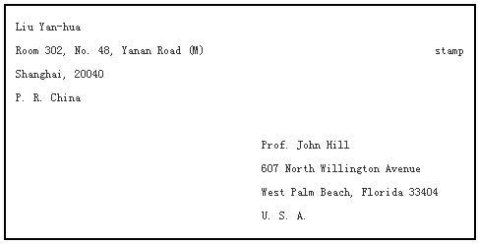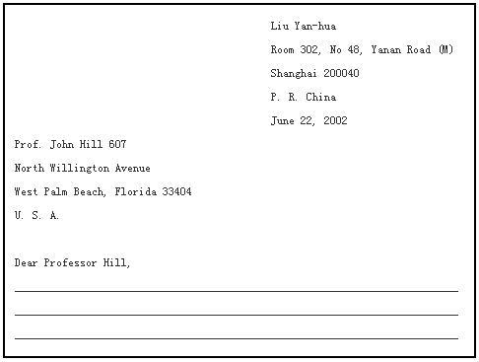篇一 :英语书信范文及格式详解
英文信分垂直式或齐头式和缩进式或锯齿式两种。
英文书信通常由下列五个部分组成(以缩进式为例):
A 信头(Heading)
信头包括写信人地址和写信日期,通常写在信笺的右上角。在比较熟识的朋友之间的通信,写信人的地址常可略去。地址的写法通常是由小到大
B 称呼(Salutation)
称呼指写信人对收信人的称呼,如Dear Xiaojun,写在信头的下方和信笺的左边。称呼一般用Dear…或My dear…开头,称呼后一般用逗号。
C 正文(Body)
这是书信的主体部分,即写信人要表达的内容。
D 结束语(Complimentary Close)
它是书信结尾的恭维话,相当于中文书信最后的“祝好”、“致礼”之类的话语。 “Best wishes”, “I love you”, “Many thanks” “Give my regards to your family”
E 签名(Signature)
签名通常签在结束语下方的中间偏右的位置,.签名应是亲笔书写,即使是打写机打出的信件,最后仍需亲笔签名。在签名的上方可根据写信人和收信人的关系写上Sincerely yours/Yours sincerely(用于长辈或朋友之间),或Respectfully yours/Yours respectfully(用于对长辈或上级)。
…… …… 余下全文
篇二 :最全英语作文书信格式模板范文
书信
书信是人们在日常生活和工作中进行交际的工具。由于民族语言和习惯上的差异,英语信件在书写格式及表达方式上与汉语不大一样,有些地方迥然不同。英文书信分为两大类:公务信件和私人信件。公务信件是单位与单位或单位与个人之间来往的书信,可能是推荐信、求职信、入学申请书、邀请信,或询问、答复、反映意见(如投诉信)等的信件。私人信件是指亲戚朋友之间的通信。这两类书信各有自己的格式。一般说来,私人信件不拘形式,信文多用手写,也可打印;公务信件要求比较严格,必须遵循一定的格式,信文一定要打印。
一般格式
英文书信的构成可分为7个部分:
信头(Heading), 日期(Date), 收信人姓名及地址(Inside Name and Address), 称呼(Salutation), 信文(Body of the letter), 结束语(Complimentary close), 署名(Signature)
信头(Heading)
信头是指发信人的单位名称或地址。一般情况下发信人只需把自己的地址写(打字,手写均可)在信的右上角,离开信纸的顶头约1英寸,占二三行或四行均可,格式如下:
① 齐头式
…… …… 余下全文
篇四 :英语信件写作


1.书信结构
英语书信结构一般有以下几个部分组成:
1)信封(envelope)。英语的信封和中文的一样,有三部分组成,即发信人地址、收信人地址和邮票。只不过英语信封的格式除了邮票所贴的位置(信封的右上角)和中文的一样外,英语信封上要写的发信人和收信人的地址和中文的大不一样。发信人的地址应写在信封的左上角,收信人的地址应写在信封偏中右偏下处,如下:
2)信头 (heading),即写发信人的地址和日期(右上角)。
3)信内姓名地址 (inside address),即写收信人的姓名和地址(左上角)。
4) 称呼 (salutation),即写对收信人的尊称(一般用Dear Mr. … ,; Dear Madam Helen,; Dear Miss…,; Dear John,; Dear Professor Smith,等)。称呼直接写在收信人地址的正下方,中间空一至二行。称呼后面的标点一般只能用逗号。以上信头、信内姓名和地址三部分的结构如下:
注:如果是相当熟悉和随便的朋友之间,因为彼此都知道对方的地址,故信头和信内的地址常常省略。
5)正文 (body),即信件内的主要内容。正文第一句句子一般和称呼之间空一至二行。
…… …… 余下全文
篇五 :英20xx语作文写作简单小技巧,瞬间帮你提分~
/kaoyan
2016英语作文写作简单小技巧,瞬间帮你提分~
一、格式
1.称呼:英语应用文称呼有这样的特点:
1)如果是不认识的人,一般称呼为敬词+尊称。例如,Dear Sir or Madam 或者 To Whom It May Concern (需注意每个单词首字母都大写)。
2)如果是写给关系正式的某团体或个人,称呼为敬词+尊称+名。例如,Dear Mr. Xx,或Dear Ms.xx,;
3)对于关系较亲密的人可以直呼其名,即 Dear xx,。
同时需要注意的是:1.称呼要顶格写;2. 称呼之后要加逗号或者冒号。这里推荐大家用逗号,因为历年的高分范文都是用逗号的。
2.正文:正文格式一般有两种格式:一是缩进式,即首段开头空四个字母,段落之间不空行; 另一种是齐头式,即每段开头不空格,但是各段之间空一行。跨考教育肖方方老师建议考生采用缩进式,因为如果用齐头式,段间空行的话很可能答题空间不够,导致字数不够。
3.结语:结语要注意要留出两行。一行是靠后写类似汉语“此致敬礼”的话也就是“Sincerely yours, ”或者“Yours sincerely ,”一定要注意这个地方的结尾是有逗号的,如果丢掉了逗号,则会扣掉一份,请大家一定要注意。同时,还需要注意落款,落款部分不能写自己
…… …… 余下全文
篇六 :英文书信格式及范文
英文书信格式及范文
一、 英文书信的结构
二、 书信作文的出题形式和写作要领
三、 书信作文练习及其参考范文
书信是重要的交际工具。英文书信分为两大类:公务信件和私人信件。公务信件是单位与单位或单位与个人之间来往的书信,可能是推荐信、求职信、入学申请书、邀请信,或询问、答复、反映意见(如投诉信)等的信件。私人信件是指亲戚朋友之间的通信。这两类书信各有自己的格式。一般说来,私人信件不拘形式,信文多用手写,也可打印;公务信件要求比较严格,必须遵循一定的格式,信文一定要打印。
第一节 英文书信的结构
英文书信一般由以下六部分组成:信头、信内地址、称呼、正文、结尾、签名。
1. 信头(Heading)
信头是指写信人的地址和写信日期, 一般写在或打在第一面信纸的右上角,先写地址再写日期,地址的写法是从小到大,先写门牌号、路号,再写区名、市名、省名,最后写国名。时间的写法对英国人和美国人而言是不同的。英国人习惯按日、月、年的顺序写,
而美国人习惯按月、日、年的顺序写。例如:
英式:1st October,1999
美式:October 1,1999
在英式时,月和年之间的逗号可用可不用,但是在美式中,必需要使用逗号。
…… …… 余下全文
篇七 :英语作文开头句式总结
1. When asked about..., the vast /overwhelming majority of most /many /quite a few people say /think/ believe/answer that... But...
当被问及…时,多数(大多数、许多)人认为(回答)…。但是…。
2. Nowadays, it is commonly /widely /generally believed /thought /held that..., but I wonder /doubt that...
如今,人们普遍认为…,但是我怀疑…。
3. When it comes to..., some think / hold / believe...
当提及…时,有人认为…。
4. Depending on personal experience, personality type and emotional concern, we find that some people hold the idea of... while others prefer...
…… …… 余下全文
篇八 :高考英语作文常用句式总结开头
作文常用句式总结开头
Recently, the problem of … has aroused people’s concern.
最近,…问题已引起人们的关注.
Internet has been playing an increasingly important role in our day-to-day life. It has brought a lot of benefits but has created some serious problems as well.
互联网已在我们的生活中扮演着越来越重要的角色.它给我们带来了许多好处,但也产生了一些严重的问题.
Nowadays, (overpopulation) has become a problem we have to face.
如今,(人口过剩)已成为我们不得不面对的问题了.
It is commonly believed that… / It is a common belief that…
人们一般认为…
Many people insist that…
很多人坚持认为…
With the development of science and technology, more and more people believe that…
随着科技的发展,越来越多的人认为…
A lot of people seem to think that…
很多人似乎认为…
引出不同观点:
People’s views on… vary from person to person. Some hold that… . However, others believe that…. 人们对…的观点因人而异.有些人认为….. 然而其他人却认为...
People may have different opinions on… 人们对…可能会有不同的见解.
Attitudes towards (drugs) vary from person to person. 人们对待吸毒的态度因人而异.
There are different opinions among people as to… 关于…. 人们的观点大不相同.
Different people hold different attitudes toward (failure). 对(失败)人们的态度各不相同.
结尾
Taking all these factors into consideration, we naturally come to the conclusion that…
把所有这些因素加以考虑,我们自然会得出结论…
Taking into account all these factors, we may reasonably come to the conclusion that…
考虑所有这些因素,我们可能会得出合理的结论…
Hence/Therefore, we’d better come to the conclusion that…
因此,我们最好得出这样的结论…
There is no doubt that (job-hopping) has its drawbacks as well as merits.
毫无疑问,跳槽有优点也有缺点.
All in all, we cannot live without… But at the same time we must try to find out new ways to cope with the problems that would arise.
总之,我们没有…是无法生活的.但同时,我们必须寻求新的解决办法来对付可能出现的新问题.
提出建议:
It is high time that we put an end to the (trend). 该是我们停止这一趋势的时候了.
It is time to take the advice of … and to put special emphasis on the improvement of …
该是采纳…的建议,并对…的进展给予特殊重视的时候了.
There is no doubt that enough concern must be paid to the problem of …
毫无疑问,对…问题应予以足够的重视.
Obviously,…. If we want to do something… , it is essential that…
显然,如果我们想做某事,很重要的是…
Only in this way can we… 只有这样,我们才能…
It must be realized that… 我们必须意识到…
预示后果:
Obviously, if we don’t control the problem, the chances are that… will lead us in danger.
很明显,如果我们不能控制这一问题,很有可能我们会陷入危险.
No doubt, unless we take effective measures, it is very likely that…
毫无疑问,除非我们采取有效措施,很可能会…
It is urgent that immediate measures should be taken to stop the situation.
很紧迫的是,应立即采取措施阻止这一事态的发展.
论证
From my point of view, it is more reasonable to support the first opinion rather than the second.
在我看来,支持第一种观点比支持第二种观点更有道理.
I cannot entirely agree with the idea that… 我无法完全同意这一观点….
Personally, I am standing on the side of … 就个人而言,我站在…的一边.
I sincerely believe that… 我真诚地相信…
In my opinion, it is more advisable to do … than to do….
在我个人看来,做…比做…更明智.
Finally, to speak frankly, there is also a more practical reason why…
给出原因:
This phenomenon exists for a number of reasons. First, … Second, … Third, …
这一现象的存在是有许多原因的.首先, … 第二, … 第三, …
Why did… ? For one thing… For another…. Perhaps the primary reason is…
为什么会…? 一个原因是… 令一个原因是… 或许其主要原因是….
I quite agree with the statement that… the reasons are chiefly as follows.
我十分赞同这一论述,即…,其主要原因如下:
列出解决办法:
Here are some suggestions for handling… 这是如何处理某事的一些建议.
The best way to solve the troubles is… 解决这些麻烦的最好办法是…
People have figured out many ways to solve this problem. 人们已找出许多办法来解决这个问题.
批判错误观点和做法:
As far as something is concerned, …. 就某事而言,…
It was obvious that… 很显然,….
It may be true that…, but it doesn’t mean that… 可能…是对的,但这并不意味着…
It is natural to believe that… , but we shouldn’t ignore that…
认为….是很自然的,但我们不应忽视….
There is no evidence to suggest that… 没有证据表明…
如何连接
强调
still, Indeed, apparently, oddly enough, of course, after all, significantly, interestingly, also, above all, surely, certainly, undoubtedly, in any case, anyway, above all, in fact, especially. Obviously, clearly.
比较
like, similarly, likewise, in the same way, in the same manner, equally.
对比
by contrast, on the contrary, while, whereas, on the other hand, unlike, instead, but, conversely, different from, however, nevertheless, otherwise, whereas, unlike, yet, in contrast.
列举
for example, for instance, such as, take …for example. Except (for), to illustrate.
时间
later, next, then, finally, at last, eventually, meanwhile, from now on, at the same time, for the time being, in the end, immediately, in the meantime, in the meanwhile, recently, soon, now and then, during, nowadays, since, lately, as soon as, afterwards, temporarily, earlier, now, after a while.
顺序
first, second, third, then, finally, to begin with, first of all, in the first place, last, next, above all, last but not the least, first and most important.
可能
presumably, probably, perhaps.
解释
in other words, in fact, as a matter of fact, that is, namely, in simpler terms.
递进
What is more, in addition, and, besides, also, furthermore, too, moreover, furthermore, as well as, additionally, again.
让步
although, after all, in spite of…, despite, even if, even though, though, admittedly, whatever may happen.
转折
however, rather than, instead of, but, yet, on the other hand, unfortunately. whereas
原因
for this reason, due to, thanks to, because, because of, as, since, owing to.
结果
as a result, thus, hence, so, therefore, accordingly, consequently, as consequence.
总结
on the whole, in conclusion, in a word, to sum up, in brief, in summary, to conclude, to summarize, in short.
其他
Mostly, occasionally, currently, naturally, mainly, exactly, evidently, frankly, commonly, for this purpose, to a large extent, for most of us, in many cases, in this case,
图表作文常用句型
As is shown in the graph… 如图所示…
The graph shows that… 图表显示…
As can be seen from the table,… 从表格中可以看出…
From the chart, we know that… 从这张表中,我们可知…
All these data clearly prove the fact that… 所有这些数据明显证明这一事实,即…
The increase of …. In the city has reached to 20%. ….在这个城市的增长已达到20%.
In 1985, the number remained the same. 1985年,这个数字保持不变.
There was a gradual decline in 1989. 1989年,出现了逐渐下降的情况.
…… …… 余下全文
